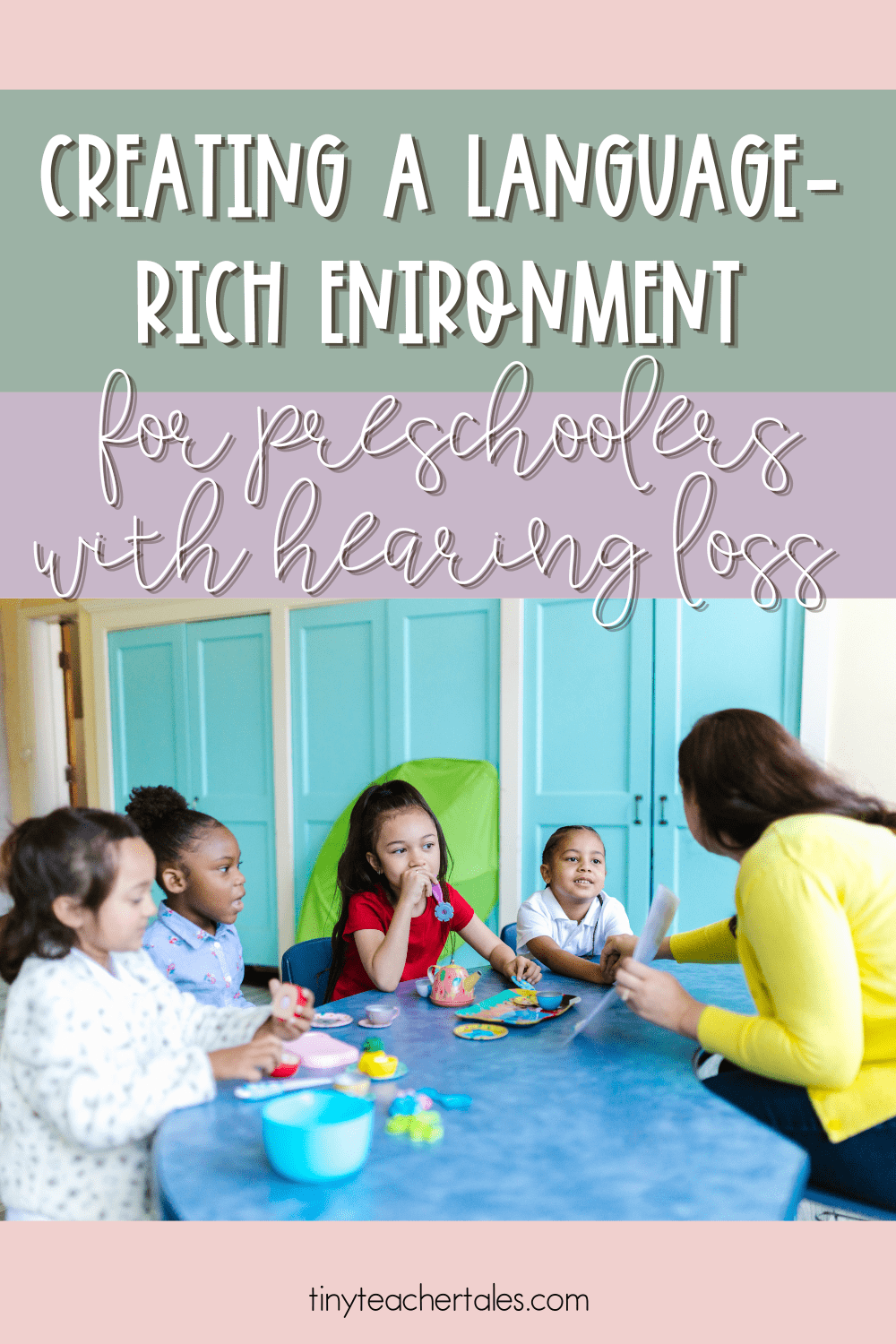As a preschool teacher specializing in listening and spoken language for children who are deaf or hard of hearing, you understand the vital role language development plays in their overall growth and education. Building a language-rich environment is crucial in supporting these young learners as they develop their auditory skills and communication abilities. We will explore essential tips for fostering language development through rich auditory experiences and meaningful conversations, empowering our preschoolers to thrive in their learning journey!
This post may contain affiliate links, which means I may receive a commission, at no extra cost to you, if you make a purchase through a link. Please see my full disclosure for further information.
Foster Natural Conversations🗣️
Encourage open and natural conversations with your preschoolers. Engage in one-on-one and group discussions about their interests, experiences, and feelings. Through meaningful interactions, children develop crucial language skills, including vocabulary expansion, grammar, and turn-taking.
Utilize Visual and Tactile Cues👀
While the focus is on auditory experiences, incorporating visual and tactile cues enhances comprehension and engagement for children with hearing loss. When using thoughtful Listening and Spoken Language strategies and techniques along with visual cues it can support the auditory information you provide. For a full list of LSL strategies and techniques, grab them here! Visual aids, such as pictures, charts, and videos, help reinforce vocabulary and concepts, making the learning experience more accessible and effective.
Create a Language-Infused Classroom🏷️
Immerse the classroom in language by labeling objects, displays, and learning materials. Preschoolers with hearing loss benefit from being constantly exposed to words and phrases in their environment. Use clear and simple language to describe activities, routines, and expectations, helping them build a strong foundation in language comprehension. Repetition is crucial for our students to be exposed to the new vocabulary and have many opportunities in hearing the vocabulary and language being used.
Storytelling and Shared Reading📖
Stories captivate young minds and serve as excellent language development tools. Engage in storytelling sessions and shared reading activities with your preschoolers. Use expressive language, animated gestures, and sound effects to make the stories come alive, igniting their imagination and language skills. Reading with our students at school and carrying reading time over into the home, is a valuable tool that is beneficial to our students’ language development. Incorporate reading into different activities! During snack time you can select a short story to read that may contain new vocab words. You can also use a story during music and sing the words in the book. Incorporate a book with your sensory bin to add an auditory element. The options are unlimited with how stories can be embedded into our classrooms and homes!


Singing and Music🎶
Music is a universal language that transcends barriers. Incorporate songs and musical activities into your daily routine. Singing along to rhymes and melodies helps with speech development, rhythm, and phonological awareness. Introduce musical instruments to explore different sounds and encourage participation. Use a clean-up song to cue your students that it is time to clean up and transition into the next activity. Songs can also be used to give directions to your students. This makes transitions easier and more engaging to follow.
Field Trips and Real-Life Experiences🐳
Take your preschoolers on field trips and real-life experiences to expose them to diverse language-rich environments. Visiting places like the zoo, museum, or local market provides opportunities for new vocabulary acquisition and language enrichment. The experiences can be free activities such as going to the grocery store, post office, a local park, farmers market and so much more! Talk about what is going on and what you see, hear, or even smell. Have the student engage in the activity by asking questions or even allowing them to purchase something.


Encourage Peer Interaction👧🏻👦🏼
Promote socialization and language exchange among our preschoolers with hearing loss. Pairing children with different language abilities encourages them to communicate and support one another in a nurturing environment. This practice fosters peer modeling and the development of social language skills. Creating a space for students to feel safe and not being “tested” allows them to try using new vocabulary and language without the pressure of performing and doing it correctly.
Incorporate Play-Based Learning🚂
Play is a natural way for children to learn and explore language. Create play-based learning opportunities that involve imaginative play, role-playing, and problem-solving. Engage in play scenarios that encourage the use of language and encourage the children to interact with one another. Including centers within the preschool schedule is an ample opportunity to allow for play-based learning. With different centers for dramatic play, sensory tables, writing, art, math, and reading, children are given options on how they want to play and develop their interests.



Partner with Families🏠
Family involvement is crucial in supporting language development at home. Communicate regularly with parents and caregivers, sharing strategies and activities that can be implemented outside of the classroom. Encourage families to read, sing, and engage in conversations with their children regularly.
Creating a language-rich environment for preschoolers with hearing loss is essential in empowering them to develop strong auditory and language skills. By utilizing a language-focused classroom, you create a supportive and nurturing atmosphere for language growth. Remember to partner with families to extend language development opportunities beyond the classroom. Together, we can help these young learners thrive and communicate confidently, setting them on a path to a successful and fulfilling educational journey!
Looking for more ideas on creating a language-rich environment? Check out this blog post!

